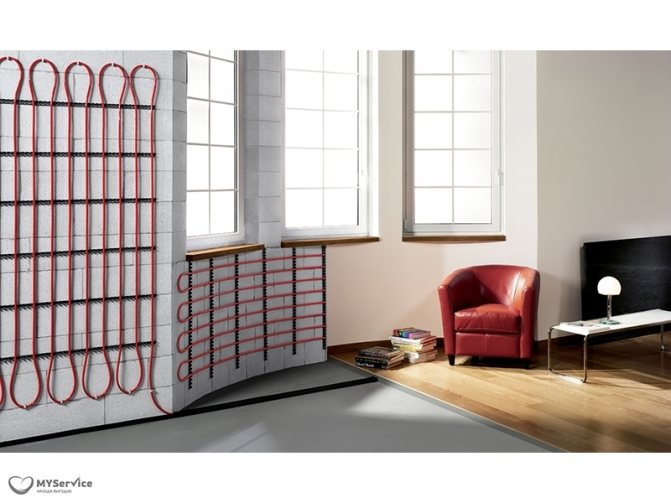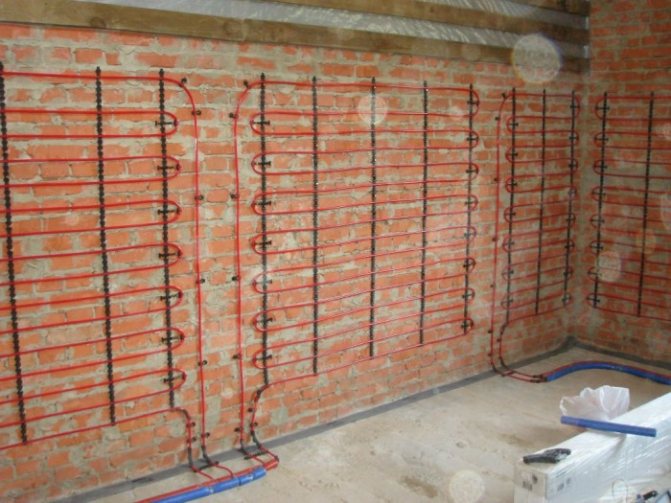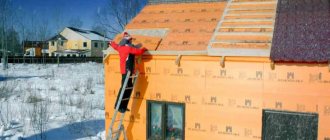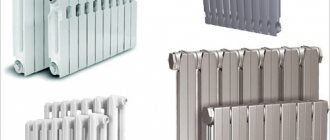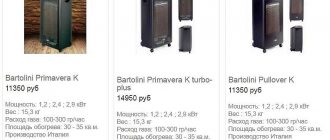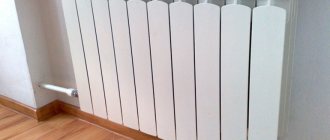
Warm walls have been used for heating buildings for a long time and this technology is not new. For example, in the palaces of St. Petersburg to this day you can find this technology, when a boiler was installed in the basement, and channels passed through the walls through which hot air circulated.
Now, this technology is back again, but only slightly transformed, instead of channels in the walls, we have tubes with a coolant or an electric cable. Let's try to understand this technology, its pros and cons, feasibility and cost-effectiveness, the impact on human health and the microclimate in the house.
Nowadays, there are many ways to heat your home and this leads to a big problem, namely the rational choice of a home heating system.
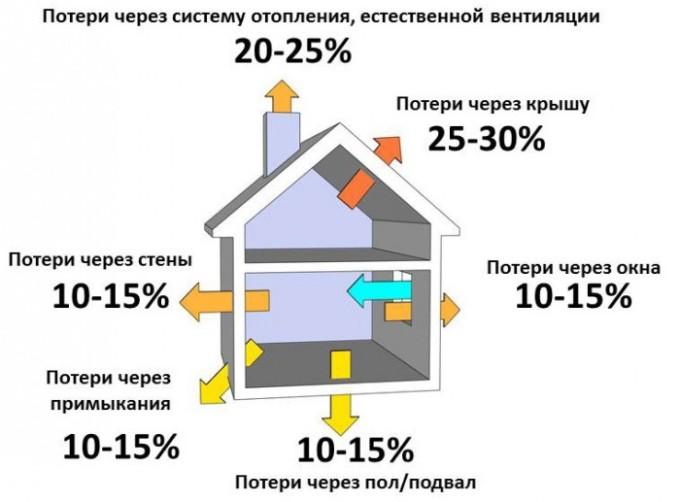

First of all, we need to figure out what a heating system is and why is it needed in a house? The main task of the heating system is to compensate for the heat loss of the house during the heating season. That is, if the house has any heat loss, for example, 30 kW / h through all the enclosing structures, then we need to compensate for these losses in order to feel comfortable in the house and maintain the temperature at 20 ° C. This is the whole mystery, the type of heating system does not play a special role and it does not matter how we will compensate for these losses, we will fire gas, coal or wood, we will use warm walls, warm floors or radiators - all this does not have any values. We need to give 30 kW / h to the house in order to compensate for the heat loss!
If we make a warm house as a system, reducing its losses, for example, by 1.5 times, then for heating we will need 20 kW / h. And now we have come to the most important thing to the choice of a heating system, or rather to a comparison of the efficiency of different systems. It's no secret that you need to choose a heating system with the highest efficiency.
How warm walls work
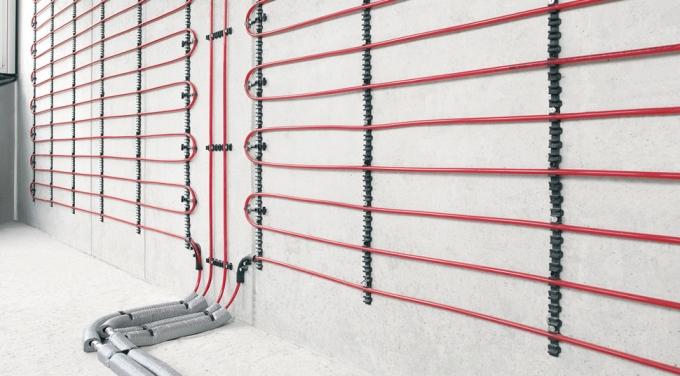

Let's take a closer look at home heating with warm walls. So what do advertising articles write to us on this technology? And the fact that using warm walls as a heating device, we increase the area of the heater, thereby lowering the temperature of the coolant.
Let's make an analogy with warm floors. For example, if we warm up a warm floor above 29 ° C, then a person begins to feel very uncomfortable, he is hot, the balance of heat exchange is disturbed. According to European standards, the temperature difference between the air and the surface of the warm floor should not be more than 9 ° C. For example, in a living room the standard temperature is 20 ° C, then we can warm up the floor to 29 ° C. If this is a bathroom, where the air temperature should be 24 ° C, then we can heat the floor to 33 ° C - no longer comfortable, less - please.
Warm walls in our country have exactly the same limitations, both from the point of view of regulatory documents and human physiology, because a higher temperature is perceived as uncomfortable. The only difference is that for walls this difference is 11 ° C.
If a wall radiates heat in a living room, then its temperature should not exceed 31 ° C. This temperature will be comfortable for a person who is at a distance of 1 m from the wall. That is, the temperature difference between the wall surface and the air will be 31 ° С - 20 ° С = 11 ° С.
[direct]
Why would a person be uncomfortable if the temperature difference is higher? We perceive temperature as contact with air, in this case there is an exchange between air and us, and the second option is as radiant heat.And this is what happens, the higher the surface temperature, the stronger the radiant heat. Therefore, a large temperature difference between the air and the heating surface will create a strong heat flow and a person does not feel comfortable in this room.
This is the whole catch, since 85% of the heat of the wall is transferred to the person by means of radiant heat. But to get these 85%, the coolant in a warm wall must have a temperature of 40 ° C. Sellers are silent about this, who recommend warm walls as a home heating system. The same temperature in the radiators of the heating system and by and large, the boiler is like heating walls or radiators. In a well-insulated house, a radiator with a coolant temperature of 40 ° C does its job well.
From this it follows that by lowering the temperature of the coolant below 40 ° C, we sharply reduce the radiant heat that the wall emits. Therefore, there is no point in making a warm wall, since we will not get that comfortable heat that we get with a higher coolant.
Comparing a warm floor and walls, we have that the projection of a person on the floor is much less than on the wall (meaning the area of contact with radiant heat). Therefore, if we say that a warm wall gives radiant heat, then its temperature should be 40 ° C, and as we already know, such a temperature is not comfortable for humans.
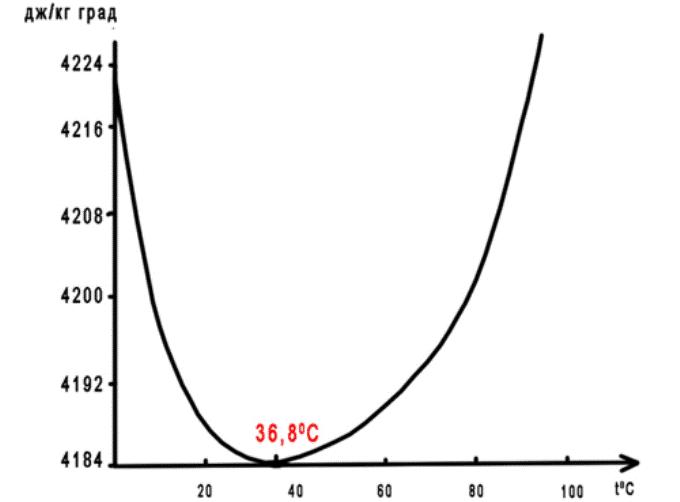

Why 40 ° C? The graph of specific heat capacity of water has a non-linear relationship. Its lowest point, where the smallest heat capacity of water, will be at 36.8 degrees. That is, this is the temperature at which it is easiest to heat water by 1, 2 or 3 degrees and less energy needs to be spent.
The statement that at a low temperature of the coolant, we need to spend less energy to heat the house is not true.
The fact is that any heating system is an intermediary, and it must heat the air around us. Since water is an intermediary, and between us and the heating device there is air, which has a low heat capacity and needs to be heated, but in what way and with what it is absolutely not important to heat it, we perceive radiant heat directly, but this requires a high temperature.
A warm wall needs a high temperature, a source of radiant heat to work effectively!
Heating riser laying in the main wall
Such fastening of heating pipes to the wall, according to many experts, has a number of disadvantages, the main of which are the following:
- within a very short period of operation from the moment of laying pipes, cracks usually appear on the wall, which is explained by thermal expansion (the temperature in this place of the wall can reach 50 - 60 ° C);
- as a rule, another potential threat is corrosion deposits. As a rule, it is inside concrete walls that rot on risers appears;
- laying heating pipes in the wall in this way is likely to lead to leaks and flooding of the neighboring ceiling.
Is heating with a warm wall at home economically viable or not?
Let's look at the insulated outer wall of our house and make a heat engineering calculation. The calculation takes into account the room temperature and the outside air temperature. Due to the warm air inside the house, the wall heats up, which comes into contact with the colder outside air and, as a result, begins to lose heat. We will compensate for these losses. The building codes say that the surface temperature of the wall inside the room should not be lower than 4 ° C from the air temperature in this room. For example, if the air temperature in the living room is 20 ° C, then the wall temperature should not be lower than 16 ° C.
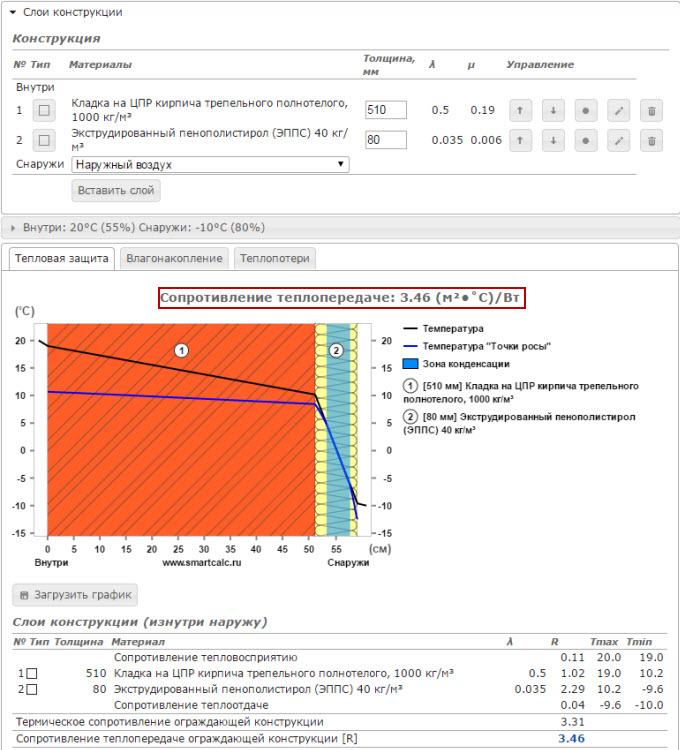

Let's take a look at the thermal design of the wall.We have a brick wall 510 mm and insulated with EPS 80 mm (the structure of the wall and the region of construction in this case does not play any role). Heat transfer resistance according to the calculator: 3.46 (m² • ˚С) / W.
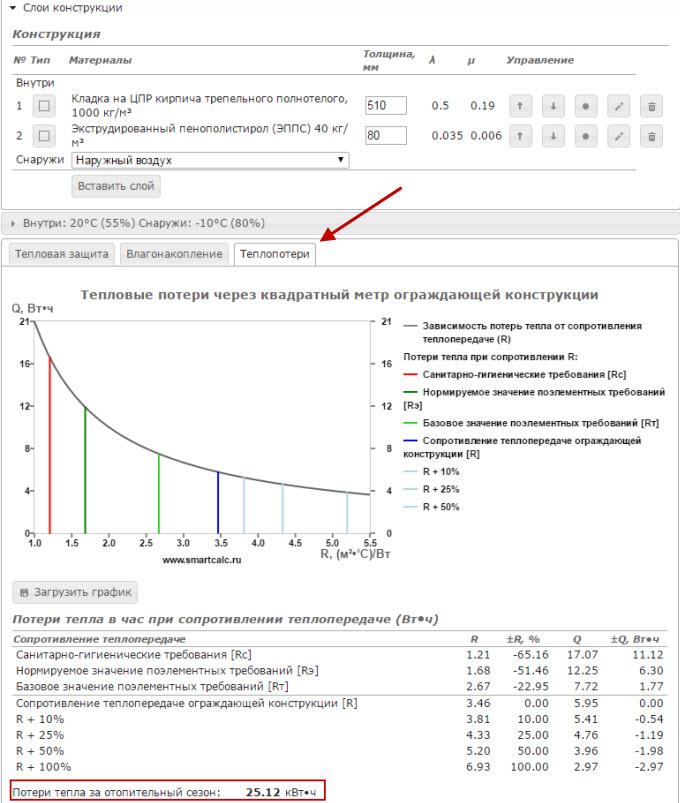

We go to the “Heat loss” tab and below we see that the heat loss for the heating season is 25.12 kWh per 1m2 of the wall. This is when the house is heated with radiators or underfloor heating. But if we install warm pipes in the walls, then the temperature of the inner part of the wall rises significantly and will no longer be 16 ° C, but 40 ° C.
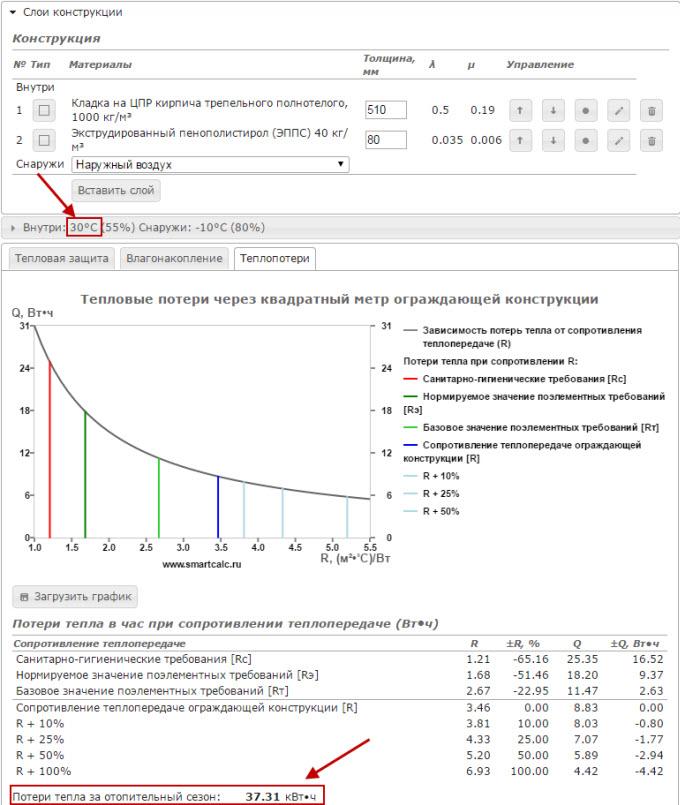

We return to the calculator again and raise the temperature to 30 ° C (unfortunately, the calculator does not allow to increase it to 40 ° C), look at the heat loss, they amount to 37.31 kWh when heated with a warm wall, which is one and a half times more than the previous result.
Conclusion: at an internal air temperature of 20 ° C, the loss of a house will be much higher if it is heated by warm walls, due to the fact that the temperature of the outer wall will be higher, and the higher the temperature difference, the greater the heat loss. During the heating season, you will need to pay more money for gas, electricity, firewood or another type of fuel.
What should be done to reduce heat loss?
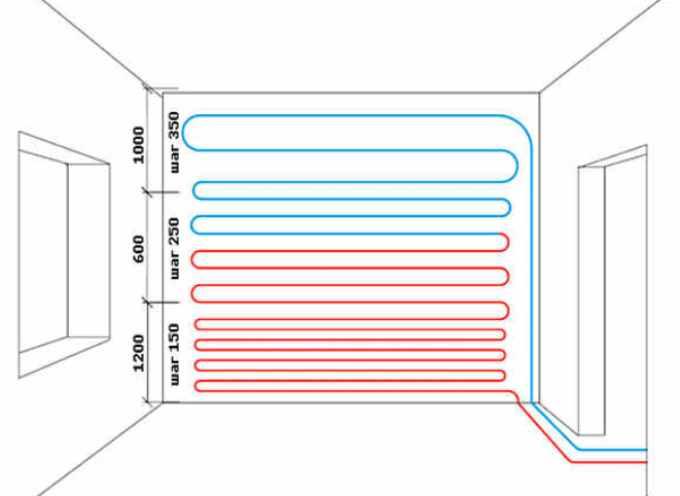

To reduce heat loss from warm walls, they need to be arranged in internal walls that do not come into contact with the outside air. In this case, we will be able to heat two rooms with one wall, if it is a partition, for example, between two bedrooms. But if the inner wall adjoins the outer wall, then we will also warm up a part of the outer wall, and this is already increased heat loss. Therefore, you need to step back from the outer wall.
You also need to remember that warm walls cannot be covered with anything, for example, place a cabinet or other interior elements near them. Also, a bed cannot be installed near warm walls, a person will not feel comfortable.
And if we make the walls that border the corridor warm, because the corridor is also a house and the warmth will remain in the house? But in the passage zones, heating is not done, since warm air gets here from the living rooms. And if you still heat the passage zones, then this excess heat will simply go out into the ventilation and again we get heat loss.
Conclusion: a warm wall can only be made between living quarters, only then we can talk about some kind of expediency and rational use of energy resources.
Reduction of heat loss, constructive solutions
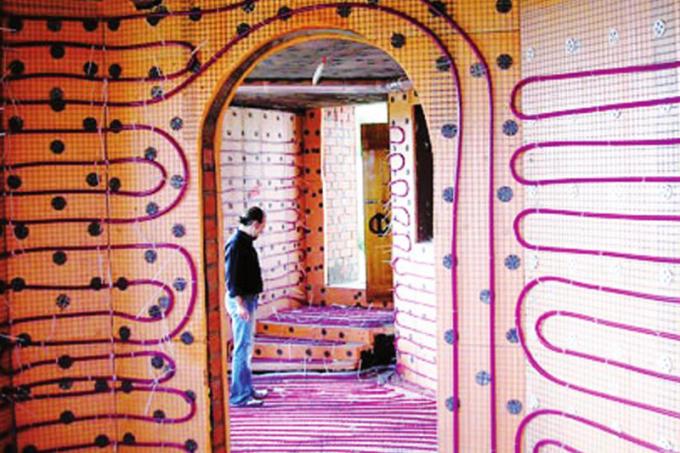

You nevertheless decided to make warm walls in the house, despite all the above arguments of the inefficiency of this technology. How to proceed?
There are two ways to get the wall structure right:
- Increase the thickness of the insulation outside.
- Install additional insulation on the inside of the wall, and then mount warm walls.
In the first case, we need to spend more money on insulation. In the second, we close the wall with insulation from the inside, thereby leveling all the properties of the wall material, creating a greenhouse effect (with EPS insulation) and nullifying such wall properties as sorption, capillary activity, inertia, etc. If the house is built of bricks, then this is essentially money wasted.
Conclusion: a warm wall is an expensive heating system for a house, which leads to an increase in costs when building a house, very dubious economy in operation, so that a person feels comfortable, you need to make all the walls in the house warm, etc.
Methods for fixing heating pipes in the wall
As a rule, it is customary among residents to hide steel heating pipes in the wall, those that have already served for a long time and have a very unpresentable appearance.
However, it is worth remembering that there are two main options for such work:
- Equip the main walls with grooves and move the racks a short distance, and then seal them up with plaster.
- Design a plasterboard box around the heating pipes.
Related article: How to glue bamboo canvas on the wall
There are also cases when the wall is completely sheathed with plasterboard. The riser in this case is located inside the false wall.
Next, mention should be made of the most common methods for covering pipes in a wall.
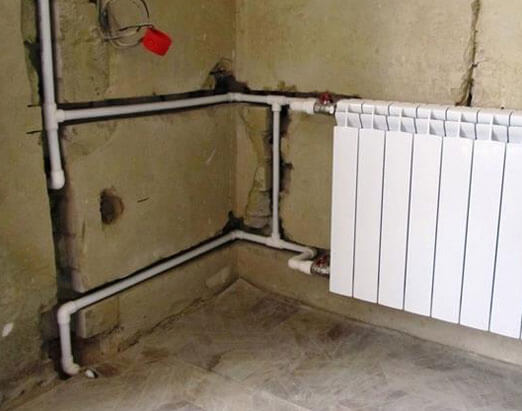

Where is the best place to use the warm wall system?


If a technology exists and allows us to solve a problem, then we cannot forget about it, we must remember it and apply it.
A warm wall can be used as an additional source of heat in places where, for some reason, it is impossible to use other technologies. For example, underfloor heating is made in the house and, due to the large amount of furniture, the open area is not enough to heat the entire volume. In this case, warm walls can come to the rescue, which will increase the heating area, since these technologies are similar and have the same operating mode.
How to maintain pipes in the wall
It is enough to observe the technology and sequence of work when placing the pipes of the heating system in the wall. It is important to choose high-quality materials and fasteners.
If the requirements are met, the structure can function for up to 50 years, depending on the manufacturer's guarantees for its materials.
It is also possible to decorate the section of the wall on which the disguised pipes are located with expensive materials.
The method of masking the heating system is quite popular, but it requires increased security measures during installation. Also, it is quite difficult to obtain permission to mask the heating system in an apartment building, since according to technical regulations, all communications must be open for free access in case of an emergency.
The effect of warm walls on a person
As with warm floors in warm walls, the main thing is not to overdo it and not to raise the temperature more than the permissible 40 ° C, since excess heat negatively affects human health.
Subjectively and psychologically, a person is much more pleasant when the wall radiates heat, and does not give off cold.
If children get used to warm floors and warm walls, then when they go to kindergarten, they immediately start to get sick, since greenhouse conditions have been created at home. The human body, being in such conditions, begins to lose immunity. Therefore, warm walls, along with warm floors, should be an additional source of heat, and not as the main one!
How to remove plastic pipes into the wall
This type of work is simpler, since it is quite possible to do it yourself, excluding the use of a welding machine. Corrosion of such pipes, of course, does not threaten, and these elements can serve up to half a century.
However, there are disadvantages to this installation method:
- the negative sides of the polypropylene used in this method of the device include its high coefficient of thermal expansion, which requires equipping the heating riser with special bends that play the role of expansion joints. This prevents plastic heating pipes from expanding inside the wall;
- the maximum temperature that polypropylene can withstand is 95 ° C, but there are situations when this parameter can be higher, which will inevitably lead to a water hammer. But such a problem will be relevant only for those owners whose heating is connected to the central system. In self-contained structures, control over heating indicators is completely carried out by residents.
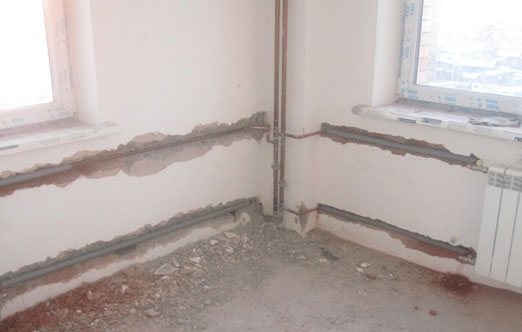

In the event that the fastening of heating pipes to the wall is carried out inside a closed plasterboard box for heating pipes or other decorative structure, subsequently the only repair method will be only to open the entire structure, which is a very laborious and inconvenient work.
The better to insulate the bath from the inside
What materials to use for the internal insulation of the bath? For the longest time in the practice of building baths are used natural materialsthat were available throughout the history of the existence of such structures. Our ancestors often insulated the inner surfaces of the bath walls with improvised materials: hemp hemp, linen tow, moss, etc. All of the above is still used today, since natural materials have a very significant advantage over other thermal insulation: they are absolutely environmentally friendly.
Related article: Which spatula to choose for wall putty
However, natural insulation has some features that significantly reduce their attractiveness. At first, the process of finishing a bath with natural thermal insulation is a very, very laborious process. Even with all the simplicity of the technology, caulking a bath with moss or tow will take an excessive amount of time.
Secondly, natural materials are attractive not only to the owner of the bath. They are very fond of being taken away by birds and small rodents according to their own needs, and insects can easily start in the layer of moss, which also do not contribute to the durability of the material. Therefore, thermal insulation of a bath made of natural materials requires regular renewal.
More modern synthetic materials completely devoid of the above-mentioned disadvantages. With no less environmental friendliness, they have a much longer service life, and in terms of thermal insulation parameters, they even surpass natural alternatives.
Among the synthetic thermal insulation materials suitable for interior decoration of the bath, most widespread expanded polystyrene, basalt fiber, mineral wool and glass wool. When deciding how and what is the best way to insulate the bath inside, it is necessary to understand that with the same purpose, each of these materials also has some differences.
- Expanded polystyrene... Its main feature is a successful combination of excellent thermal insulation, low cost and low weight. However, in relation to the bath, this material can only be used to insulate the outer walls of the dressing room. In the washing room, due to the high temperature, polystyrene foam can lose its shape, thereby violating the thermal insulation. It is generally unacceptable to use this material for warming the steam room, since it is fire hazardous.
- Basalt fiber insulation can not boast of a pleasant price tag, but in relation to the bath they can be an ideal solution. Since basalt fiber is produced from molten rocks, it has some important features:
- absolute incombustibility;
- resistance to mechanical deformation and moisture;
- excellent level of sound absorption;
- excellent thermal insulation.
Other benefits of mineral wool include:
- low thermal conductivity (guarantee of the reliability of thermal insulation);
- hydrophobicity, allowing the use of mineral wool in high humidity conditions;
- the ability to absorb sound.
Video on how to properly insulate a bath from the inside.
Glass wool... At its core, this thermal insulation material is a weave of thin inorganic glass fibers. Therefore, glass wool contains a significant amount of air in its volume, which ensures the ability to perfectly retain heat with good vapor permeability.
One of the significant advantages of glass wool over analogues is its relatively low cost. At the same time, it is always possible to choose a heater of the required thickness.On sale there are both rolls of glass wool of different widths, and industrially cut mats and slabs.
And in this photo is one of the schemes for warming the bath from the inside.
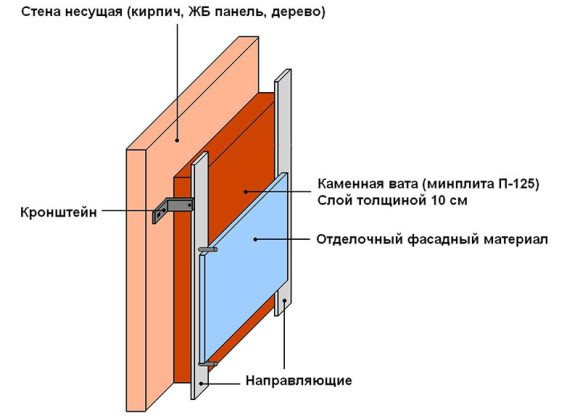

And here is an article about the insulation of baths from foam blocks.
Preparation and insulation of walls
Consider an example of installing warm water walls and floors using the example of a bath with the above environmental parameters. First you need to decide on the location of the steam room. The walls themselves do not have to be high. Naturally, a prerequisite for them is a perfectly flat and plastered surface. So, the use of a gas silicate block will allow you to achieve the desired result.
Then the thermal insulation panel is installed from, but its fastening should not be made of plastic material, since the expected high temperature in the steam room can melt the fasteners. The best option would be to "plant" the plate on a special foam. Moreover, it is necessary to apply foam to the plate twice for better fastening and to press the extruded polystyrene foam to the wall also twice. Previously, the wall is dedusted with a primer and treated with a waterproofing layer. As for the insulation of the floor, the difference from the insulation of the wall is that a polyethylene film is placed on top of the thermal insulation panel made of extruded polystyrene foam.
- Simply press against the extruded polystyrene foam. Then there will be no gap between the mesh and the polystyrene.
- Attach with a chemical dowel with two washers to achieve a distance of about one centimeter between the mesh and the polystyrene. This will allow the pipe to be located farther from the wall, due to this it is better to warm up the room. A chemical dowel must be used if a gas block (or foam block) is the basis of the wall masonry. In the event that a brick or other material is used, you can dispense with conventional anchors as an attachment. According to the technique of performing the work, it is more convenient to first cut the mesh, then fix it.
Stage three: installing a warm floor
The above-mentioned underfloor heating model is quite convenient to install, because it looks like a self-adhesive polymer mesh with a cable fixed on it, which heats the room. The mesh must be spread over the entire surface, the protection removed from the adhesive base and fixed to the wall. The adhesive base of the heating mat is not designed for vertical fixing, which is why additional fixation is required using aluminum tape. In accordance with the instructions for installing a warm floor, it is required to prepare special leads in order to connect a special sensor and electrical power in the future.
